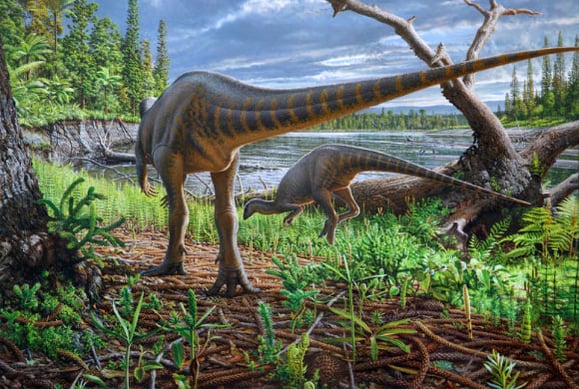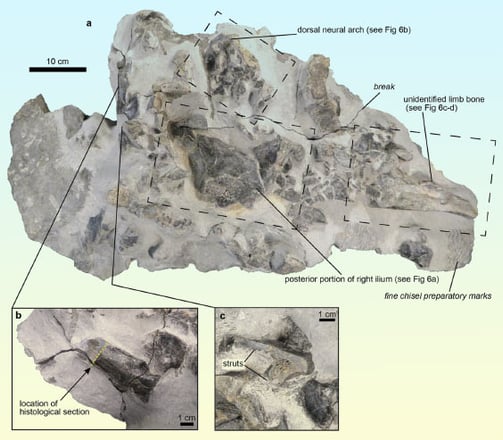🦕 Rare Dinosaur Skeleton Unearthed in Scotland: A Middle Jurassic Marvel
Anurag Maurya
4/30/20253 min read


In a discovery that’s making waves in the paleontology world, scientists have unearthed the most complete Middle Jurassic dinosaur skeleton ever found in Scotland. The fossil was discovered on the Isle of Skye, within the renowned Kilmaluag Formation — a site that has become increasingly important in the study of prehistoric life. This rare find, dating back approximately 166 million years, is shedding new light on a time in Earth's history that has long been underrepresented in the fossil record.
📜 A Glimpse into the Middle Jurassic
The Middle Jurassic period was a crucial phase in dinosaur evolution. It marked a time of significant diversification, transitioning from the relatively small and agile dinosaurs of the Triassic and Early Jurassic to the massive and varied giants of the Late Jurassic.
Dr. Elsa Panciroli, a paleobiologist at National Museums Scotland, highlighted the importance of this era:
“Dinosaurs from the Triassic and Early Jurassic were generally small, bipedal carnivores and omnivores, but by the Late Jurassic they had radiated into a highly diverse range of species that included some of the largest terrestrial vertebrates to ever walk the Earth.”
Yet, despite its evolutionary significance, the Middle Jurassic fossil record remains extremely sparse and globally rare. This has made it difficult for scientists to fully understand how and why dinosaurs diversified so rapidly during this period.
🏞 The Kilmaluag Formation: A Paleontological Treasure
The fossil in question was originally spotted in 1973, but it wasn’t until 2018 that researchers recognized its value and carefully collected it. What makes this specimen so remarkable is its relative completeness — it consists of numerous associated bones and fragments, all preserved on a single bedding plane roughly 60 cm by 40 cm.
This site — the Kilmaluag Formation — has become a critical locality for Jurassic fossil discoveries in the UK. This latest find has further solidified its importance by revealing what may be the youngest known ornithopod dinosaur in Scotland and possibly the first from the Kilmaluag Formation.
Ornithopods are herbivorous dinosaurs and form a subgroup within the Ornithischia. If this identification is confirmed, the fossil would add a key data point to our understanding of dinosaur distribution and ecosystem structure during the Middle Jurassic.
🔬 Filling Evolutionary Gaps
The rarity of fossils from the Middle Jurassic has left many evolutionary mysteries unresolved. This discovery helps address some of those gaps, offering insights into:
The physical characteristics of Middle Jurassic dinosaurs
The transition and diversification of dinosaur groups during this time
The ecological environments they inhabited
As noted in the study published in the Earth and Environmental Science Transactions of the Royal Society of Edinburgh, fossils like this are essential to reconstructing the evolutionary tree and understanding the biodiversity of that era.
“New dinosaur finds from the Middle Jurassic are therefore highly significant for our understanding of the development of dinosaur-dominated ecosystems,” the researchers emphasized.
🌍 Why This Discovery Matters
This fossil is more than just a rare piece of prehistoric bone — it’s a time capsule offering a glimpse into a world that once was. It helps scientists understand how dinosaurs came to dominate the Earth and how ecosystems evolved to support such a dramatic rise in diversity.
Moreover, it highlights the importance of long-term fossil conservation, as this specimen sat unnoticed for decades before its significance was understood. It also reinforces the Isle of Skye’s growing reputation as one of the most important Jurassic fossil sites in the world.
📢 Final Thoughts
As science continues to unearth the secrets buried beneath our feet, discoveries like this remind us of how much there is still to learn about our planet’s distant past. The Middle Jurassic dinosaur skeleton from the Isle of Skye isn’t just a scientific breakthrough — it’s a symbol of the patience, curiosity, and dedication that drives paleontology forward.


An artist’s impression of an ornithischian dinosaur. Image credit: Peter Trusler.
The 166-million-year-old skeleton of an ornithischian dinosaur from the Kilmaluag Formation, the Isle of Skye. Image credit: Panciroli et al., doi: 10.1017/S1755691024000148.
email: science@geoprimex.com
© 2024. All rights reserved.
Whatsapp: +919044995188
Contact Informaton
Important links
anuragmaurya80@gmail.com
